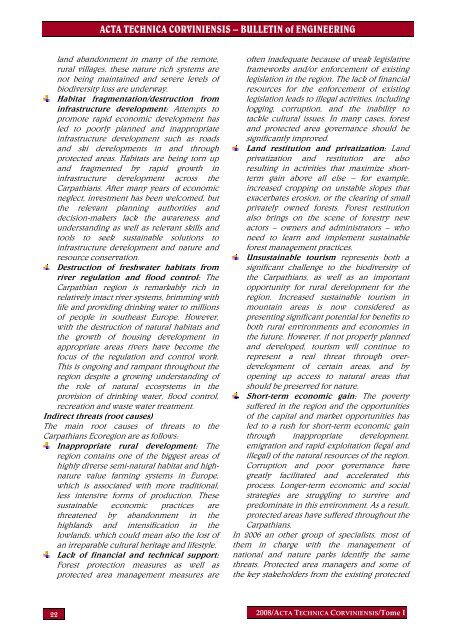Acta Technica Corviniensis
Acta Technica Corviniensis
Acta Technica Corviniensis
- No tags were found...
Create successful ePaper yourself
Turn your PDF publications into a flip-book with our unique Google optimized e-Paper software.
ACTA TECHNICA CORVINIENSIS – BULLETIN of ENGINEERINGland abandonment in many of the remote,rural villages, these nature rich systems arenot being maintained and severe levels ofbiodiversity loss are underway.Habitat fragmentation/destruction frominfrastructure development: Attempts topromote rapid economic development hasled to poorly planned and inappropriateinfrastructure development such as roadsand ski developments in and throughprotected areas. Habitats are being torn upand fragmented by rapid growth ininfrastructure development across theCarpathians. After many years of economicneglect, investment has been welcomed, butthe relevant planning authorities anddecision-makers lack the awareness andunderstanding as well as relevant skills andtools to seek sustainable solutions toinfrastructure development and nature andresource conservation.Destruction of freshwater habitats fromriver regulation and flood control: TheCarpathian region is remarkably rich inrelatively intact river systems, brimming withlife and providing drinking water to millionsof people in southeast Europe. However,with the destruction of natural habitats andthe growth of housing development inappropriate areas rivers have become thefocus of the regulation and control work.This is ongoing and rampant throughout theregion despite a growing understanding ofthe role of natural ecosystems in theprovision of drinking water, flood control,recreation and waste water treatment.Indirect threats (root causes)The main root causes of threats to theCarpathians Ecoregion are as follows:Inappropriate rural development: Theregion contains one of the biggest areas ofhighly diverse semi-natural habitat and highnaturevalue farming systems in Europe,which is associated with more traditional,less intensive forms of production. Thesesustainable economic practices arethreatened by abandonment in thehighlands and intensification in thelowlands, which could mean also the lost ofan irreparable cultural heritage and lifestyle.Lack of financial and technical support:Forest protection measures as well asprotected area management measures areoften inadequate because of weak legislativeframeworks and/or enforcement of existinglegislation in the region. The lack of financialresources for the enforcement of existinglegislation leads to illegal activities, includinglogging, corruption, and the inability totackle cultural issues. In many cases, forestand protected area governance should besignificantly improved.Land restitution and privatization: Landprivatization and restitution are alsoresulting in activities that maximize shorttermgain above all else – for example,increased cropping on unstable slopes thatexacerbates erosion, or the clearing of smallprivately owned forests. Forest restitutionalso brings on the scene of forestry newactors – owners and administrators – whoneed to learn and implement sustainableforest management practices.Unsustainable tourism represents both asignificant challenge to the biodiversity ofthe Carpathians, as well as an importantopportunity for rural development for theregion. Increased sustainable tourism inmountain areas is now considered aspresenting significant potential for benefits toboth rural environments and economies inthe future. However, if not properly plannedand developed, tourism will continue torepresent a real threat through overdevelopmentof certain areas, and byopening up access to natural areas thatshould be preserved for nature.Short-term economic gain: The povertysuffered in the region and the opportunitiesof the capital and market opportunities hasled to a rush for short-term economic gainthrough inappropriate development,emigration and rapid exploitation (legal andillegal) of the natural resources of the region.Corruption and poor governance havegreatly facilitated and accelerated thisprocess. Longer-term economic and socialstrategies are struggling to survive andpredominate in this environment. As a result,protected areas have suffered throughout theCarpathians.In 2006 an other group of specialists, most ofthem in charge with the management ofnational and nature parks identify the samethreats. Protected area managers and some ofthe key stakeholders from the existing protected222008/ACTA TECHNICA CORVINIENSIS/Tome I
















